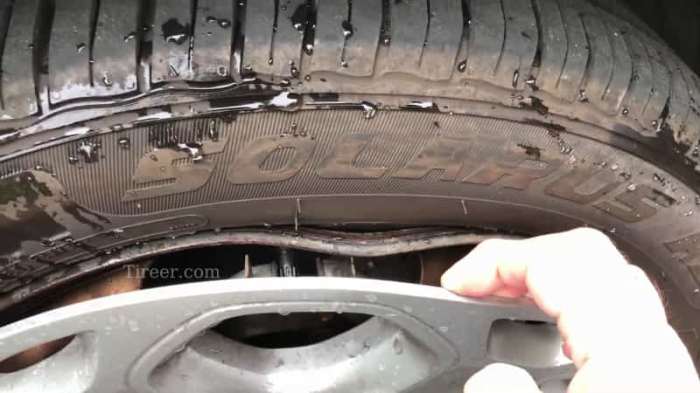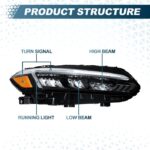Symptoms of a bent wheel rim? Yeah, that’s a total bummer. We’re talking wobbly rides, weird vibrations, and potentially some seriously unsafe driving conditions. This isn’t just about a cosmetic issue; a bent rim can impact your handling, tire wear, and even your safety. So, let’s dive into the telltale signs, from subtle shakes to full-blown wobbles, and figure out what’s up with your wheels.
This guide covers everything from visually inspecting your rims for damage to understanding how a bent rim affects your car’s performance. We’ll explore how a seemingly small bend can lead to uneven tire wear, potential suspension damage, and even safety hazards. We’ll also look at some diagnostic tools and techniques that can help you confirm a bent rim and assess the severity of the damage.
Get ready to become a wheel-whisperer!
Visual Inspection of a Bent Wheel Rim

Okay, so you think your wheel might be bent? Before you panic and start ordering new rims, let’s talk about how to visually assess the damage. A thorough visual inspection is the first and often most important step in diagnosing a bent wheel. It’s much cheaper than replacing a wheel unnecessarily!
Identifying a bent wheel rim involves carefully examining its surface for irregularities. Sometimes, the damage is obvious, while other times, it requires a keen eye and possibly some tools to detect.
Typical Visual Signs of a Bent Wheel Rim
Several visual cues can indicate a bent wheel rim. Recognizing these signs early can prevent further damage and potential safety hazards.
- Visible Bends or Kinks: This is the most obvious sign. You might see a noticeable bend in the rim’s lip, spokes, or even the center section.
- Uneven Tire Contact Patch: The tire might not sit flush against the rim’s surface. You might see bulges or dips in the tire’s sidewall.
- Wheel Wobble: When rotating the wheel, it might wobble or shake noticeably. This is often easier to detect by spinning the wheel while holding it.
- Changes in Wheel Diameter: A severely bent rim might show a slight change in its overall diameter, though this is harder to detect without precision measuring tools.
- Scratches or Dents: While not always indicative of a bend, deep scratches or dents, especially in the rim’s structural areas, can suggest underlying damage.
Differences Between Slightly Bent and Severely Bent Rims
The severity of a bent rim significantly impacts both handling and safety. A small bend might be barely noticeable, whereas a severe bend can be dangerous.
| Severity | Visual Cue | Impact on Handling | Impact on Safety |
|---|---|---|---|
| Slight Bend | Minor wobble, slightly uneven tire contact, barely visible bend | Slight vibration at higher speeds, may feel a little off-center | Minimal, but potential for increased tire wear and eventual failure |
| Severe Bend | Significant wobble, uneven tire contact, large visible bend or kink, possible cracks | Noticeable vibration and pull to one side, significant handling issues, potentially unsafe to drive | High; risk of tire blowout, wheel failure, and loss of control |
Tire Wear Patterns Indicating a Bent Wheel Rim
Uneven tire wear can be a subtle yet crucial indicator of a bent wheel. Consistent patterns suggest an underlying mechanical issue.
For example, if one side of the tire wears significantly faster than the other, this could suggest that the wheel is out of true. This uneven wear might manifest as cupping (wear concentrated on the center or edges of the tire) or feathering (wear concentrated on one side of the tire tread). These are strong indicators of a possible wheel rim problem and warrant a closer inspection.
Driving Symptoms of a Bent Wheel Rim
A bent wheel rim significantly impacts your driving experience, often manifesting as noticeable changes in vehicle handling and ride comfort. These symptoms can range from subtle vibrations to complete loss of control, depending on the severity of the bend and the speed at which you’re driving. Ignoring these symptoms can lead to further damage to your vehicle, including tire wear and suspension components.Driving with a bent rim is markedly different from the smooth ride of a properly balanced wheel.
At low speeds, you might feel a slight pull or wobble, while at higher speeds, the vibrations and instability become much more pronounced. The effects are felt throughout the vehicle, not just in the steering wheel.
Vibration and Instability at Varying Speeds
A bent wheel rim disrupts the smooth rotation of the wheel, causing vibrations that increase proportionally with speed. At lower speeds (under 30 mph), you might feel a slight shimmy or pull in the steering wheel, perhaps a subtle rumble in the floorboard. As speed increases, these vibrations intensify. Above 40 mph, the vibrations can become quite strong, affecting the steering wheel, seat, and floorboard.
So, you think your wheel’s bent? Look for vibrations, uneven tire wear, or a wobbly ride. These issues can be a major headache, especially if you’re dealing with a high-end vehicle, which brings up the whole concept of NFT integration in luxury car ownership – imagine an NFT verifying your rim’s pristine condition! Getting back to those bent rims, a professional inspection is always the best bet to avoid further damage.
At highway speeds (65+ mph), driving can become dangerous due to significant instability and potential loss of control. The severity depends on the extent of the bend; a minor bend might only cause noticeable vibrations at higher speeds, while a severe bend will create noticeable problems even at low speeds.
Vibrations Felt Throughout the Vehicle
The vibrations caused by a bent wheel rim are not isolated to the steering wheel. The imbalance and uneven contact patch with the road surface transmit vibrations throughout the vehicle’s structure. These vibrations can be felt in the steering wheel, the seat, and even the floorboard. The intensity of these vibrations directly correlates with the speed of the vehicle and the severity of the rim’s bend.
Imagine driving a car with a washing machine inside—that’s a somewhat accurate, albeit exaggerated, description of the feeling of significant vibrations. A severely bent rim can make driving extremely uncomfortable and even dangerous.
Comparison of Driving Experiences, Symptoms of a bent wheel rim
The following table highlights the key differences between driving with a bent wheel rim and driving with a properly aligned and balanced wheel:
| Feature | Bent Wheel Rim | Properly Aligned and Balanced Wheel |
|---|---|---|
| Steering Wheel | Vibrations, pulling, difficulty maintaining a straight line, especially at higher speeds. | Smooth, responsive steering; maintains a straight line effortlessly. |
| Ride Comfort | Rough ride, noticeable vibrations in steering wheel, seat, and floorboard; discomfort increases with speed. | Smooth, comfortable ride; minimal vibrations. |
| Vehicle Stability | Reduced stability, especially at higher speeds; potential for loss of control. | Excellent stability; predictable handling. |
| Tire Wear | Uneven tire wear due to inconsistent contact patch. | Even tire wear. |
Impact on Tire and Suspension
A bent wheel rim doesn’t just affect your ride comfort; it directly impacts the health of your tires and suspension system. The uneven contact patch created by the bent rim leads to premature wear and potential damage to other critical components. Ignoring a bent rim can quickly escalate a minor inconvenience into a costly repair bill.The uneven surface of a bent rim forces your tire to contact the road inconsistently.
This uneven pressure distribution causes accelerated and irregular wear patterns on the tire tread. Imagine a perfectly round tire being forced onto a slightly oval-shaped rim. The parts of the tire that are stretched over the more outwardly bent portion of the rim will experience increased friction and wear, leading to a faster rate of degradation compared to areas that sit more naturally on the rim.
Uneven Tire Wear Patterns
A bent rim typically results in one side of the tire wearing down significantly faster than the other. You might see a feathering effect, where the tread wears away at an angle, or a cupping pattern, with uneven wear across the tread width. In severe cases, you could observe significant bald spots on one side of the tire, while the opposite side retains a relatively deep tread.
This uneven wear compromises tire grip and handling, making the vehicle less stable and potentially dangerous. Visualize a tire with one side exhibiting a noticeably shallower tread depth than the other, with the edges of the tread showing significant wear. The worn areas will appear more angular and less uniform compared to a properly worn tire.
Damage to Suspension Components
A bent rim can also transmit vibrations and uneven forces throughout your suspension system. These irregular forces can place additional stress on components like ball joints, tie rod ends, and control arms. Over time, this can lead to premature wear and tear, requiring more frequent and potentially costly replacements. For example, the constant jarring from a significantly bent rim might accelerate the wear of ball joints, causing them to become loose and eventually fail, resulting in a loss of steering control.
Similarly, the increased stress on tie rod ends could lead to premature failure and compromised steering responsiveness.
Impact Based on Bend Severity
The severity of the impact on your tire and suspension directly correlates with how severely the rim is bent. A minor bend might only cause slightly uneven tire wear, requiring a little more frequent tire rotation. However, a severely bent rim can lead to rapid tire degradation, requiring premature replacement. Furthermore, a significant bend could cause noticeable vibrations and handling issues, potentially leading to substantial damage to suspension components and potentially requiring expensive repairs or replacements.
Consider a scenario where a small bend only causes a slight pull to one side, requiring only slightly more frequent tire rotations, while a severe bend leads to significant vibration, compromised handling, and the potential for premature failure of multiple suspension components.
Methods of Detection Beyond Visual Inspection

Visual inspection is a great first step in checking for bent rims, but sometimes a more precise method is needed to confirm suspicions or quantify the damage. Fortunately, several tools and techniques exist to help mechanics and enthusiasts alike accurately assess wheel rim condition. These methods offer a level of detail that goes beyond what’s visible to the naked eye, leading to more accurate diagnoses and repairs.
Wheel Balancing Machine Analysis
A wheel balancing machine is primarily designed to identify and correct imbalances in a wheel assembly, but it can also indirectly reveal a bent rim. During the balancing process, the machine spins the wheel at high speed while measuring its runout—the radial and lateral deviation from a perfect circle. Significant runout readings, especially if they’re consistent across multiple rotations, strongly suggest a bent rim.
The machine’s readings provide numerical data, making it far more precise than a visual assessment alone. For example, a runout exceeding 0.05 inches (1.27 mm) might indicate a noticeable bend requiring attention. This objective data is crucial for determining the severity of the bend and the necessary repair.
Wheel Straightener Assessment
A wheel straightener is a specialized piece of equipment used to correct bent rims. While its primary function is repair, it can also be used diagnostically. By mounting the wheel on the straightener, a technician can observe the wheel’s response to pressure. The amount of force required to straighten the rim, along with the wheel’s resistance, provides an indication of the bend’s severity.
A severely bent rim will require significantly more force and may show more resistance compared to a slightly bent one. The technician can directly observe the areas of greatest deformation, which may not be readily apparent during a visual inspection. This hands-on assessment offers a comprehensive understanding of the bend’s nature and location.
A bent wheel rim often shows up as vibrations in the steering wheel, especially at higher speeds. Figuring out what’s wrong can be tricky, though; sometimes a symptom like that could be totally unrelated to the wheels, so if you’re stumped, check out this guide on How to troubleshoot car electrical problems to rule out electrical gremlins.
Then, if it’s still vibrating, you can confidently focus back on your wheels.
Run-Out Gauge Measurement Procedure
A run-out gauge provides a direct and precise measurement of wheel rim imperfections. It’s a simple yet effective tool that allows for a quantitative assessment of the bend. Here’s a step-by-step procedure for using a run-out gauge:
- Secure the Wheel: Mount the wheel securely on a sturdy, level surface, ensuring it’s not wobbling or moving during the measurement process. A wheel balancer can be helpful here, or a workbench with a suitable clamping mechanism.
- Position the Gauge: Place the run-out gauge’s measuring tip against the wheel rim at a specific point. Ensure the gauge is perpendicular to the rim’s surface for accurate readings.
- Record Initial Reading: Record the initial reading displayed on the gauge. This serves as your baseline.
- Rotate the Wheel: Slowly rotate the wheel by hand, keeping the gauge in consistent contact with the rim. Observe the gauge’s readings as you rotate.
- Note Variations: Record the highest and lowest readings observed during the rotation. The difference between these readings represents the total runout, which directly indicates the extent of the rim’s imperfection. A larger difference indicates a more significant bend.
- Repeat Measurements: Repeat steps 2-5 at several points around the wheel rim, at least four to six points spaced evenly. This will provide a more comprehensive picture of the rim’s condition and identify the locations of the most significant bends.
The collected data from multiple points helps create a detailed profile of the wheel’s imperfections, allowing for a precise assessment of the damage.
Safety Implications of Driving with a Bent Rim: Symptoms Of A Bent Wheel Rim

Driving on a bent wheel rim is significantly more dangerous than it might initially seem. The seemingly minor imperfection can lead to a cascade of problems, dramatically increasing the risk of accidents and serious injury. Ignoring a bent rim puts both the driver and other road users at risk.A bent rim compromises the structural integrity of the wheel, creating a weak point that can easily fail under stress.
This weakness directly impacts tire performance and vehicle control, leading to several serious safety concerns.
Tire Blowouts
A bent rim can cause uneven tire pressure distribution. This uneven pressure leads to excessive wear on one part of the tire, potentially causing a blowout. Imagine the tire bulging outward at the point where the rim is bent; this puts immense stress on the tire’s sidewall, eventually causing it to fail, especially at higher speeds or during sharp turns.
A sudden blowout at highway speeds can result in complete loss of control, leading to a serious accident. The force of a blowout can also cause the vehicle to swerve unexpectedly, potentially leading to collisions with other vehicles or objects.
Impact on Braking Performance
A bent rim can also negatively affect braking performance. The uneven contact between the tire and the road surface, caused by the deformed rim, reduces the effectiveness of braking. This means that the vehicle will require a longer stopping distance than normal, increasing the risk of rear-end collisions or other accidents. The compromised braking ability is particularly dangerous in emergency situations where immediate stopping power is crucial.
Consider a scenario where a driver needs to brake suddenly to avoid an obstacle; a bent rim could significantly hinder their ability to do so safely.
Damage to Other Vehicle Components
Continuing to drive on a severely bent rim can cause damage to other vehicle components. The uneven forces exerted on the suspension system due to the bent wheel can lead to premature wear and tear on components like ball joints, tie rod ends, and control arms. These parts are critical for steering and suspension function, and their failure can result in loss of control and accidents.
Additionally, the vibrations caused by the bent rim can transmit through the vehicle, potentially damaging other parts such as the wheel bearings, axles, and even the transmission. The cumulative cost of repairing this secondary damage can far exceed the cost of replacing the damaged wheel.
Final Thoughts
So, there you have it – a bent wheel rim is no joke. From the subtle vibrations to the potential for a blowout, it’s a problem that needs addressing ASAP. Knowing the symptoms, understanding the potential damage, and recognizing the safety implications are key to keeping yourself and your ride safe on the road. Regularly inspecting your wheels and seeking professional help when needed is always the best approach.
Stay safe out there!









